Essay on Business Decision Making: Module BABS, Level 4, Suffolk
VerifiedAdded on 2022/12/28
|8
|1277
|76
Essay
AI Summary
This essay analyzes business decision-making processes within the context of ABA plc, a branded cycle organization. It explores the use of payback period and net present value (NPV) methods to evaluate investment projects, comparing their effectiveness in financial analysis. The essay includes calculations for both methods, comparing the results and their implications. Furthermore, it examines both financial factors, like income, cost of goods, and interest rates, and non-financial factors such as taxes and government policies, to provide a holistic view of the decision-making process. The conclusion emphasizes the importance of financial and non-financial elements in business decision-making, offering insights into how these factors affect business growth and development, with references to relevant academic literature.

Business Decision Making
Paraphrase This Document
Need a fresh take? Get an instant paraphrase of this document with our AI Paraphraser
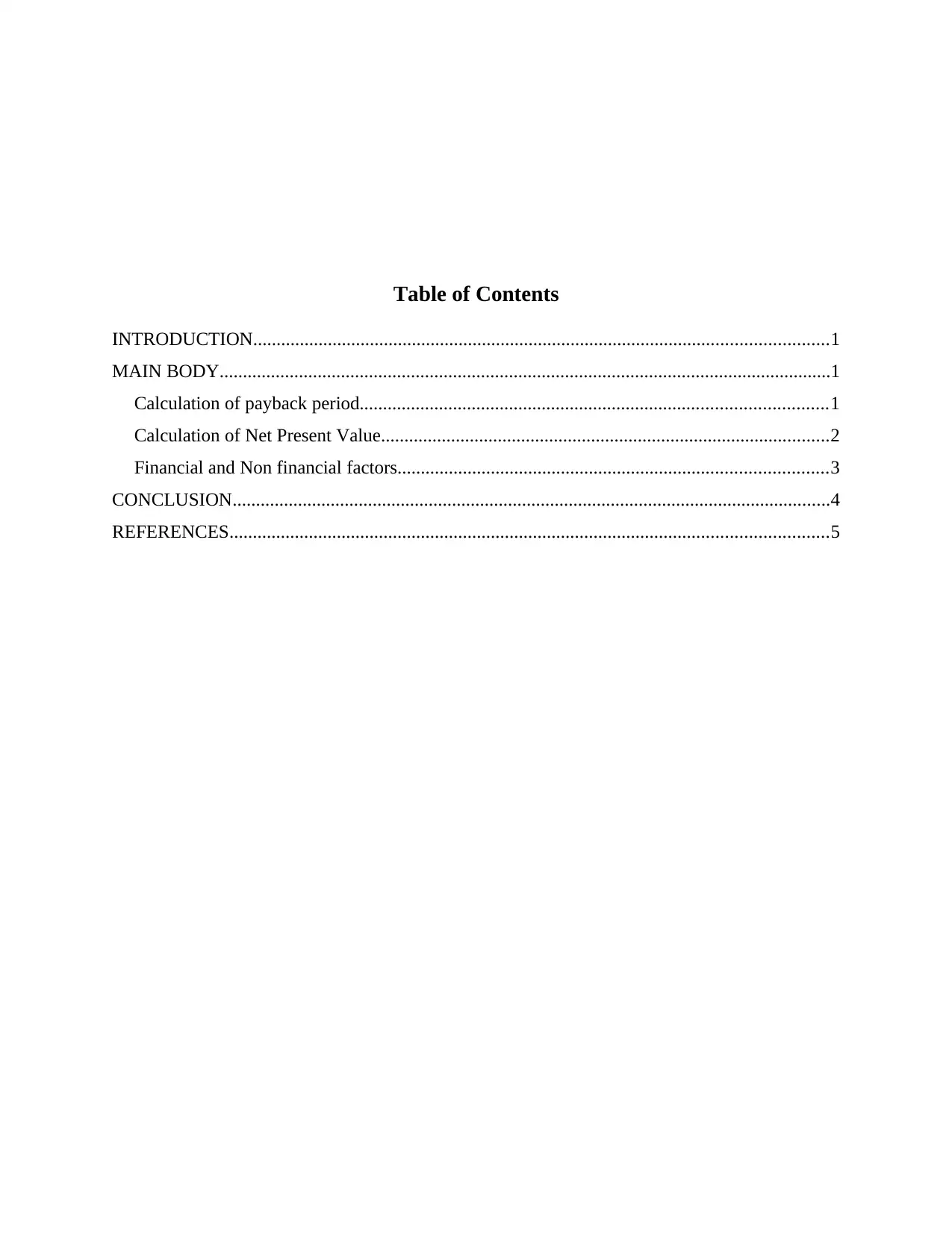
Table of Contents
INTRODUCTION...........................................................................................................................1
MAIN BODY...................................................................................................................................1
Calculation of payback period....................................................................................................1
Calculation of Net Present Value................................................................................................2
Financial and Non financial factors............................................................................................3
CONCLUSION................................................................................................................................4
REFERENCES................................................................................................................................5
INTRODUCTION...........................................................................................................................1
MAIN BODY...................................................................................................................................1
Calculation of payback period....................................................................................................1
Calculation of Net Present Value................................................................................................2
Financial and Non financial factors............................................................................................3
CONCLUSION................................................................................................................................4
REFERENCES................................................................................................................................5
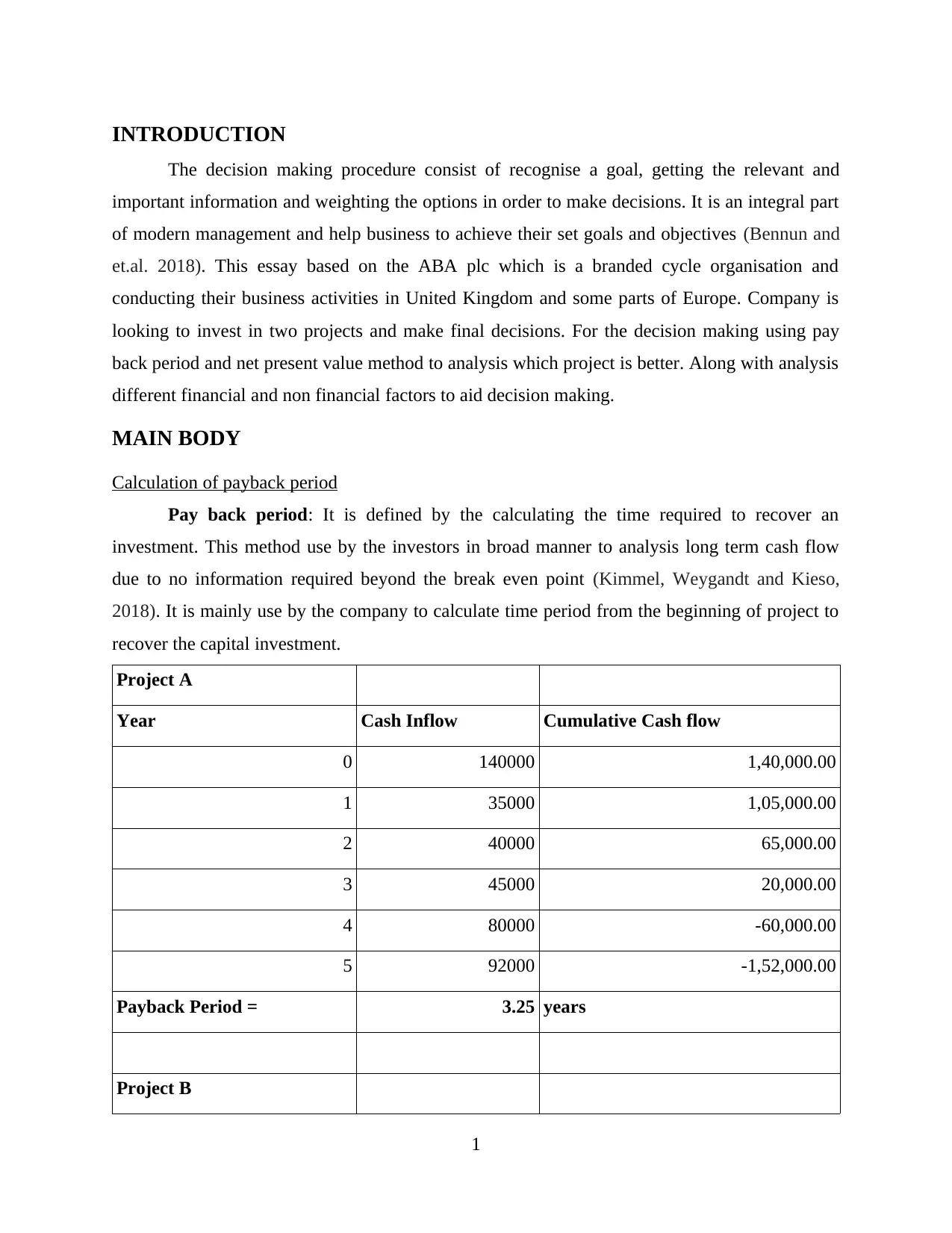
INTRODUCTION
The decision making procedure consist of recognise a goal, getting the relevant and
important information and weighting the options in order to make decisions. It is an integral part
of modern management and help business to achieve their set goals and objectives (Bennun and
et.al. 2018). This essay based on the ABA plc which is a branded cycle organisation and
conducting their business activities in United Kingdom and some parts of Europe. Company is
looking to invest in two projects and make final decisions. For the decision making using pay
back period and net present value method to analysis which project is better. Along with analysis
different financial and non financial factors to aid decision making.
MAIN BODY
Calculation of payback period
Pay back period: It is defined by the calculating the time required to recover an
investment. This method use by the investors in broad manner to analysis long term cash flow
due to no information required beyond the break even point (Kimmel, Weygandt and Kieso,
2018). It is mainly use by the company to calculate time period from the beginning of project to
recover the capital investment.
Project A
Year Cash Inflow Cumulative Cash flow
0 140000 1,40,000.00
1 35000 1,05,000.00
2 40000 65,000.00
3 45000 20,000.00
4 80000 -60,000.00
5 92000 -1,52,000.00
Payback Period = 3.25 years
Project B
1
The decision making procedure consist of recognise a goal, getting the relevant and
important information and weighting the options in order to make decisions. It is an integral part
of modern management and help business to achieve their set goals and objectives (Bennun and
et.al. 2018). This essay based on the ABA plc which is a branded cycle organisation and
conducting their business activities in United Kingdom and some parts of Europe. Company is
looking to invest in two projects and make final decisions. For the decision making using pay
back period and net present value method to analysis which project is better. Along with analysis
different financial and non financial factors to aid decision making.
MAIN BODY
Calculation of payback period
Pay back period: It is defined by the calculating the time required to recover an
investment. This method use by the investors in broad manner to analysis long term cash flow
due to no information required beyond the break even point (Kimmel, Weygandt and Kieso,
2018). It is mainly use by the company to calculate time period from the beginning of project to
recover the capital investment.
Project A
Year Cash Inflow Cumulative Cash flow
0 140000 1,40,000.00
1 35000 1,05,000.00
2 40000 65,000.00
3 45000 20,000.00
4 80000 -60,000.00
5 92000 -1,52,000.00
Payback Period = 3.25 years
Project B
1
⊘ This is a preview!⊘
Do you want full access?
Subscribe today to unlock all pages.

Trusted by 1+ million students worldwide
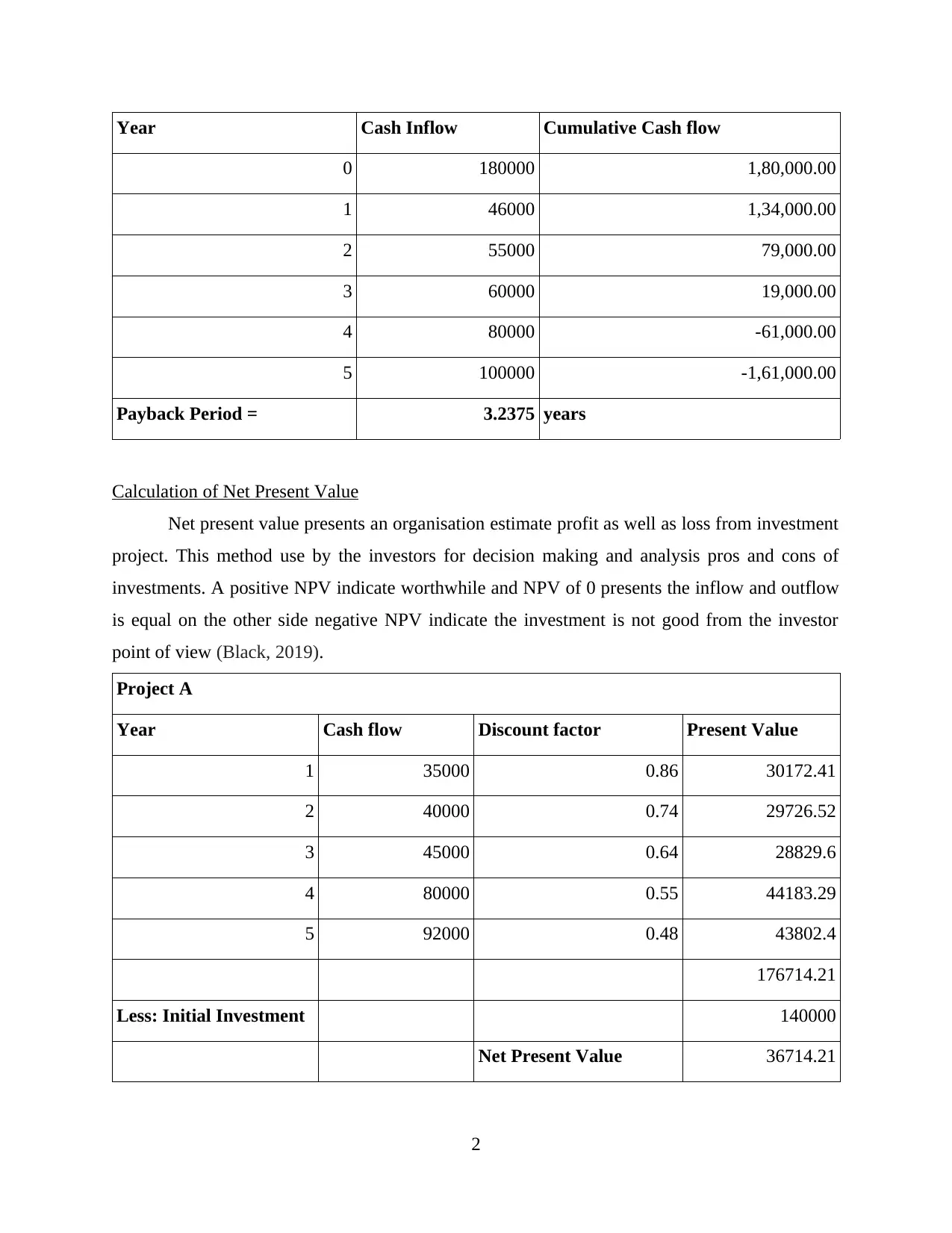
Year Cash Inflow Cumulative Cash flow
0 180000 1,80,000.00
1 46000 1,34,000.00
2 55000 79,000.00
3 60000 19,000.00
4 80000 -61,000.00
5 100000 -1,61,000.00
Payback Period = 3.2375 years
Calculation of Net Present Value
Net present value presents an organisation estimate profit as well as loss from investment
project. This method use by the investors for decision making and analysis pros and cons of
investments. A positive NPV indicate worthwhile and NPV of 0 presents the inflow and outflow
is equal on the other side negative NPV indicate the investment is not good from the investor
point of view (Black, 2019).
Project A
Year Cash flow Discount factor Present Value
1 35000 0.86 30172.41
2 40000 0.74 29726.52
3 45000 0.64 28829.6
4 80000 0.55 44183.29
5 92000 0.48 43802.4
176714.21
Less: Initial Investment 140000
Net Present Value 36714.21
2
0 180000 1,80,000.00
1 46000 1,34,000.00
2 55000 79,000.00
3 60000 19,000.00
4 80000 -61,000.00
5 100000 -1,61,000.00
Payback Period = 3.2375 years
Calculation of Net Present Value
Net present value presents an organisation estimate profit as well as loss from investment
project. This method use by the investors for decision making and analysis pros and cons of
investments. A positive NPV indicate worthwhile and NPV of 0 presents the inflow and outflow
is equal on the other side negative NPV indicate the investment is not good from the investor
point of view (Black, 2019).
Project A
Year Cash flow Discount factor Present Value
1 35000 0.86 30172.41
2 40000 0.74 29726.52
3 45000 0.64 28829.6
4 80000 0.55 44183.29
5 92000 0.48 43802.4
176714.21
Less: Initial Investment 140000
Net Present Value 36714.21
2
Paraphrase This Document
Need a fresh take? Get an instant paraphrase of this document with our AI Paraphraser
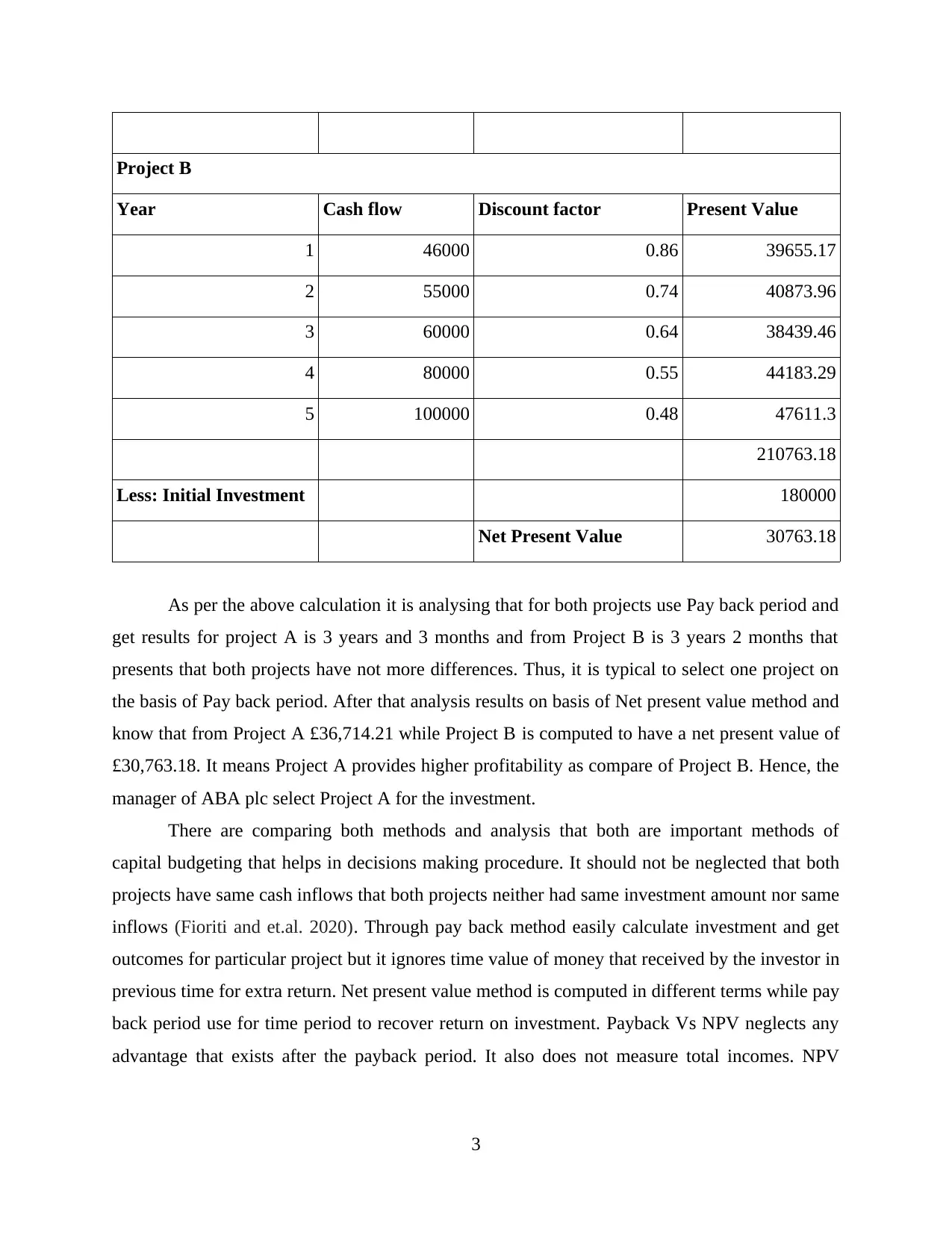
Project B
Year Cash flow Discount factor Present Value
1 46000 0.86 39655.17
2 55000 0.74 40873.96
3 60000 0.64 38439.46
4 80000 0.55 44183.29
5 100000 0.48 47611.3
210763.18
Less: Initial Investment 180000
Net Present Value 30763.18
As per the above calculation it is analysing that for both projects use Pay back period and
get results for project A is 3 years and 3 months and from Project B is 3 years 2 months that
presents that both projects have not more differences. Thus, it is typical to select one project on
the basis of Pay back period. After that analysis results on basis of Net present value method and
know that from Project A £36,714.21 while Project B is computed to have a net present value of
£30,763.18. It means Project A provides higher profitability as compare of Project B. Hence, the
manager of ABA plc select Project A for the investment.
There are comparing both methods and analysis that both are important methods of
capital budgeting that helps in decisions making procedure. It should not be neglected that both
projects have same cash inflows that both projects neither had same investment amount nor same
inflows (Fioriti and et.al. 2020). Through pay back method easily calculate investment and get
outcomes for particular project but it ignores time value of money that received by the investor in
previous time for extra return. Net present value method is computed in different terms while pay
back period use for time period to recover return on investment. Payback Vs NPV neglects any
advantage that exists after the payback period. It also does not measure total incomes. NPV
3
Year Cash flow Discount factor Present Value
1 46000 0.86 39655.17
2 55000 0.74 40873.96
3 60000 0.64 38439.46
4 80000 0.55 44183.29
5 100000 0.48 47611.3
210763.18
Less: Initial Investment 180000
Net Present Value 30763.18
As per the above calculation it is analysing that for both projects use Pay back period and
get results for project A is 3 years and 3 months and from Project B is 3 years 2 months that
presents that both projects have not more differences. Thus, it is typical to select one project on
the basis of Pay back period. After that analysis results on basis of Net present value method and
know that from Project A £36,714.21 while Project B is computed to have a net present value of
£30,763.18. It means Project A provides higher profitability as compare of Project B. Hence, the
manager of ABA plc select Project A for the investment.
There are comparing both methods and analysis that both are important methods of
capital budgeting that helps in decisions making procedure. It should not be neglected that both
projects have same cash inflows that both projects neither had same investment amount nor same
inflows (Fioriti and et.al. 2020). Through pay back method easily calculate investment and get
outcomes for particular project but it ignores time value of money that received by the investor in
previous time for extra return. Net present value method is computed in different terms while pay
back period use for time period to recover return on investment. Payback Vs NPV neglects any
advantage that exists after the payback period. It also does not measure total incomes. NPV
3
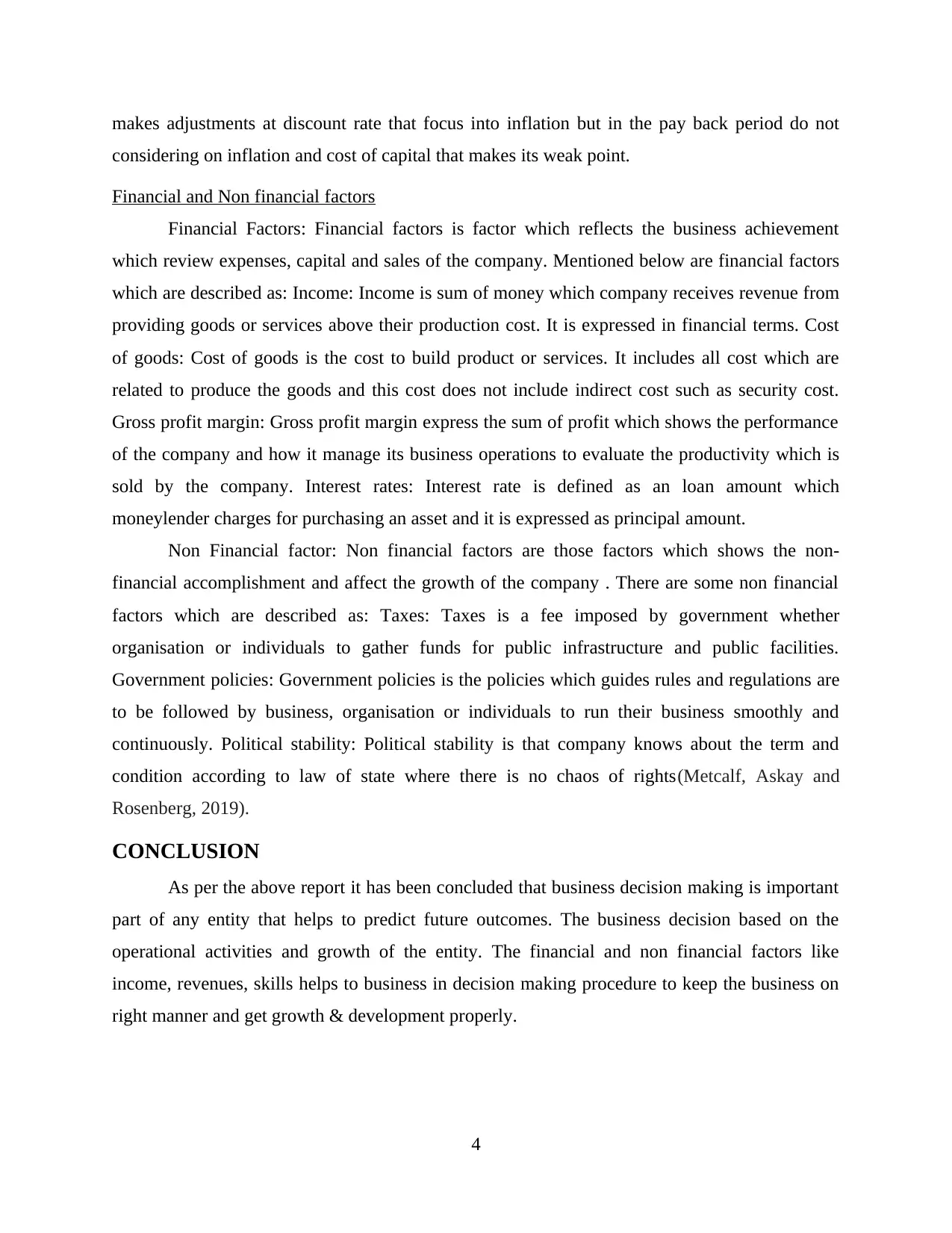
makes adjustments at discount rate that focus into inflation but in the pay back period do not
considering on inflation and cost of capital that makes its weak point.
Financial and Non financial factors
Financial Factors: Financial factors is factor which reflects the business achievement
which review expenses, capital and sales of the company. Mentioned below are financial factors
which are described as: Income: Income is sum of money which company receives revenue from
providing goods or services above their production cost. It is expressed in financial terms. Cost
of goods: Cost of goods is the cost to build product or services. It includes all cost which are
related to produce the goods and this cost does not include indirect cost such as security cost.
Gross profit margin: Gross profit margin express the sum of profit which shows the performance
of the company and how it manage its business operations to evaluate the productivity which is
sold by the company. Interest rates: Interest rate is defined as an loan amount which
moneylender charges for purchasing an asset and it is expressed as principal amount.
Non Financial factor: Non financial factors are those factors which shows the non-
financial accomplishment and affect the growth of the company . There are some non financial
factors which are described as: Taxes: Taxes is a fee imposed by government whether
organisation or individuals to gather funds for public infrastructure and public facilities.
Government policies: Government policies is the policies which guides rules and regulations are
to be followed by business, organisation or individuals to run their business smoothly and
continuously. Political stability: Political stability is that company knows about the term and
condition according to law of state where there is no chaos of rights(Metcalf, Askay and
Rosenberg, 2019).
CONCLUSION
As per the above report it has been concluded that business decision making is important
part of any entity that helps to predict future outcomes. The business decision based on the
operational activities and growth of the entity. The financial and non financial factors like
income, revenues, skills helps to business in decision making procedure to keep the business on
right manner and get growth & development properly.
4
considering on inflation and cost of capital that makes its weak point.
Financial and Non financial factors
Financial Factors: Financial factors is factor which reflects the business achievement
which review expenses, capital and sales of the company. Mentioned below are financial factors
which are described as: Income: Income is sum of money which company receives revenue from
providing goods or services above their production cost. It is expressed in financial terms. Cost
of goods: Cost of goods is the cost to build product or services. It includes all cost which are
related to produce the goods and this cost does not include indirect cost such as security cost.
Gross profit margin: Gross profit margin express the sum of profit which shows the performance
of the company and how it manage its business operations to evaluate the productivity which is
sold by the company. Interest rates: Interest rate is defined as an loan amount which
moneylender charges for purchasing an asset and it is expressed as principal amount.
Non Financial factor: Non financial factors are those factors which shows the non-
financial accomplishment and affect the growth of the company . There are some non financial
factors which are described as: Taxes: Taxes is a fee imposed by government whether
organisation or individuals to gather funds for public infrastructure and public facilities.
Government policies: Government policies is the policies which guides rules and regulations are
to be followed by business, organisation or individuals to run their business smoothly and
continuously. Political stability: Political stability is that company knows about the term and
condition according to law of state where there is no chaos of rights(Metcalf, Askay and
Rosenberg, 2019).
CONCLUSION
As per the above report it has been concluded that business decision making is important
part of any entity that helps to predict future outcomes. The business decision based on the
operational activities and growth of the entity. The financial and non financial factors like
income, revenues, skills helps to business in decision making procedure to keep the business on
right manner and get growth & development properly.
4
⊘ This is a preview!⊘
Do you want full access?
Subscribe today to unlock all pages.

Trusted by 1+ million students worldwide

5
Paraphrase This Document
Need a fresh take? Get an instant paraphrase of this document with our AI Paraphraser
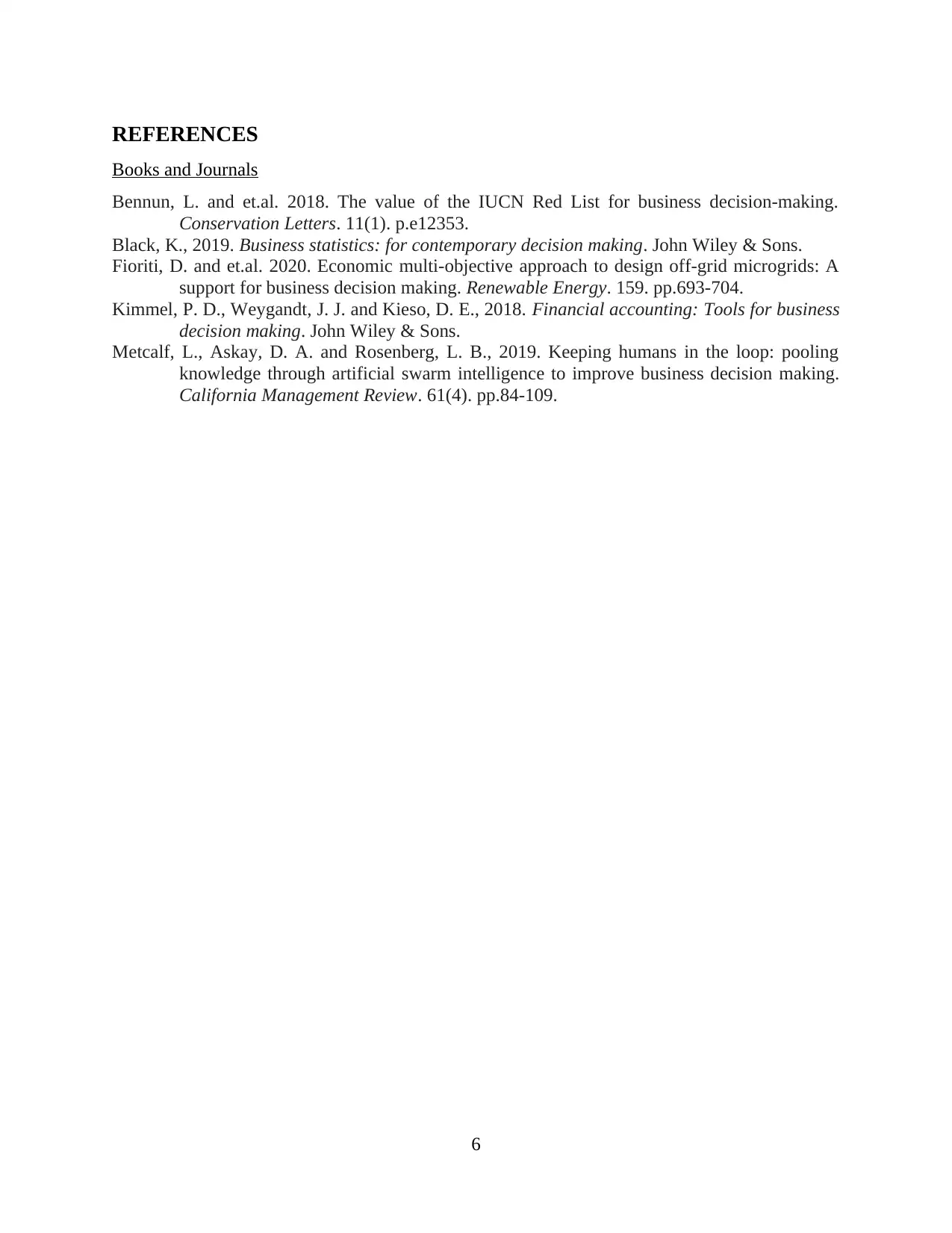
REFERENCES
Books and Journals
Bennun, L. and et.al. 2018. The value of the IUCN Red List for business decision‐making.
Conservation Letters. 11(1). p.e12353.
Black, K., 2019. Business statistics: for contemporary decision making. John Wiley & Sons.
Fioriti, D. and et.al. 2020. Economic multi-objective approach to design off-grid microgrids: A
support for business decision making. Renewable Energy. 159. pp.693-704.
Kimmel, P. D., Weygandt, J. J. and Kieso, D. E., 2018. Financial accounting: Tools for business
decision making. John Wiley & Sons.
Metcalf, L., Askay, D. A. and Rosenberg, L. B., 2019. Keeping humans in the loop: pooling
knowledge through artificial swarm intelligence to improve business decision making.
California Management Review. 61(4). pp.84-109.
6
Books and Journals
Bennun, L. and et.al. 2018. The value of the IUCN Red List for business decision‐making.
Conservation Letters. 11(1). p.e12353.
Black, K., 2019. Business statistics: for contemporary decision making. John Wiley & Sons.
Fioriti, D. and et.al. 2020. Economic multi-objective approach to design off-grid microgrids: A
support for business decision making. Renewable Energy. 159. pp.693-704.
Kimmel, P. D., Weygandt, J. J. and Kieso, D. E., 2018. Financial accounting: Tools for business
decision making. John Wiley & Sons.
Metcalf, L., Askay, D. A. and Rosenberg, L. B., 2019. Keeping humans in the loop: pooling
knowledge through artificial swarm intelligence to improve business decision making.
California Management Review. 61(4). pp.84-109.
6
1 out of 8
Related Documents
Your All-in-One AI-Powered Toolkit for Academic Success.
+13062052269
info@desklib.com
Available 24*7 on WhatsApp / Email
![[object Object]](/_next/static/media/star-bottom.7253800d.svg)
Unlock your academic potential
Copyright © 2020–2025 A2Z Services. All Rights Reserved. Developed and managed by ZUCOL.





